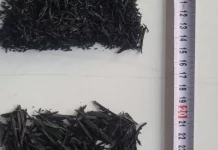DM Monitoring
LANZHOU: Xu Xi was engrossed in each stroke of the imprinting knife when carving a mold, knowing that the bronze pot it produces may one day become a symbol of wealth for a Tibetan family.
Without written instructions or a sketch, the 33-year-old artisan engraved the eight auspicious patterns of Tibetan culture all by memory, adding another tint of mystery to the bronzeware craftsmanship that has been passed down orally from father to son for five centuries.
Using recyclable sand to make single-use molds, the bronzeware making technique is an intangible cultural heritage in Qingshui, a Han-ethnic village in the impoverished county of Minxian, northwest China’s Gansu Province.
Despite the absence of copper mines in the proximity, the craft has thrived in the village by melting waste copper collected from nearby, which in the modern era includes electric wires and vehicle radiators.
Their main clients have been Tibetan families in Gansu, Qinghai, Sichuan and Tibet, whose fondness for copper utensils and ornaments and rising purchasing power have helped many Qingshui villagers shake off poverty.
“All my bronze pots have sold out, and the orders kept me busy throughout the year,” said Xu, who earns between 100,000 and 200,000 yuan (about 14,600 to 29,200 U.S. dollars) a year.
In an exhibition hall of a local cooperative dedicated to bronzeware production, a variety of bronze works are on display, from discreet kettles to gigantic pots used by Buddhist temples to cook congee.
Xu Fanglong, one founder of the cooperative, recalled the days when they sold their products to itinerant traders, who then traveled to heavily Tibetan regions to barter with herdsmen for rare herbs and cattle.
“Nowadays many Tibetan families drive cars to our village to directly buy from us using cash,” said the 45-year-old veteran craftsman.
Their growing wealth is also evident in the surging orders for more pricey, opulently decorated bronzeware that can be passed down as family assets, said artisans in Qingshui.
“In my father’s era, copper kettles were sold without lids,” he said. “Now customers prefer those with a lid, even though an ornate lid could be as expensive as the kettle.”
The market boom has helped keep the complicated craft afloat. The production involves over a dozen manual procedures and culminates with the smashing of the molds to retrieve the finished products. This makes each bronze work unique but also time-consuming to produce.
Around 2007, the lack of profitability and laborious nature of the craft prompted many artisans to leave the village for better-paying jobs in cities, Xu recalled.
Xu also considered taking up a mason’s job back then, but eventually decided to stay upon the persuasion of local officials, who conferred on him an honorary title as the master of the cultural heritage.
In recent years, the local government also revved up efforts to preserve the ancient technique while integrating it into the local poverty-reduction drive.
“We’ve been asking master artisans to recruit more apprentices, especially those from needy families,” said Yang Fengming, Party secretary of Qingshui Township, which administers the village.
The prospering trade helped slash the village’s poverty incidence from about 26 percent in 2013 to 3.8 percent by the end of 2019, Yang said, adding that they have been injecting funds into the cooperative, hoping its production expansion would benefit more low-income families.
Xu Fanglong is now proud of his new job offering guidance to any villagers working at the cooperative. He lost count of the number of his “apprentices” but said some were even older than him.






